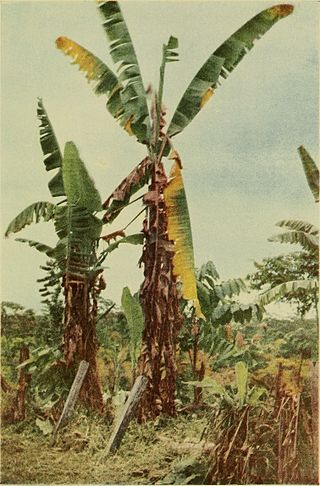
Fusarium ear blight (FEB), is a fungal disease of cereals, including wheat, barley, oats, rye and triticale. FEB is caused by a range of Fusarium fungi, which infects the heads of the crop, reducing grain yield. The disease is often associated with contamination by mycotoxins produced by the fungi already when the crop is growing in the field. The disease can cause severe economic losses as mycotoxin-contaminated grain cannot be sold for food or feed.

Fusarium wilt is a common vascular wilt fungal disease, exhibiting symptoms similar to Verticillium wilt. This disease has been investigated extensively since the early years of this century. The pathogen that causes Fusarium wilt is Fusarium oxysporum. The species is further divided into formae speciales based on host plant.

Panama disease is a plant disease that infects banana plants. It is a wilting disease caused by the fungus Fusarium oxysporum f. sp. cubense (Foc). The pathogen is resistant to fungicides and its control is limited to phytosanitary measures.

Fusarium is a large genus of filamentous fungi, part of a group often referred to as hyphomycetes, widely distributed in soil and associated with plants. Most species are harmless saprobes, and are relatively abundant members of the soil microbial community. Some species produce mycotoxins in cereal crops that can affect human and animal health if they enter the food chain. The main toxins produced by these Fusarium species are fumonisins and trichothecenes. Despite most species apparently being harmless, some Fusarium species and subspecific groups are among the most important fungal pathogens of plants and animals.

The trichothecenes are a large family of chemically related mycotoxins. They are produced by various species of Fusarium, Myrothecium, Trichoderma/Podostroma, Trichothecium, Cephalosporium, Verticimonosporium, and Stachybotrys. Chemically, trichothecenes are a class of sesquiterpenes.

Gibberella zeae, also known by the name of its anamorph Fusarium graminearum, is a fungal plant pathogen which causes fusarium head blight (FHB), a devastating disease on wheat and barley. The pathogen is responsible for billions of dollars in economic losses worldwide each year. Infection causes shifts in the amino acid composition of wheat, resulting in shriveled kernels and contaminating the remaining grain with mycotoxins, mainly deoxynivalenol (DON), which inhibits protein biosynthesis; and zearalenone, an estrogenic mycotoxin. These toxins cause vomiting, liver damage, and reproductive defects in livestock, and are harmful to humans through contaminated food. Despite great efforts to find resistance genes against F. graminearum, no completely resistant variety is currently available. Research on the biology of F. graminearum is directed towards gaining insight into more details about the infection process and reveal weak spots in the life cycle of this pathogen to develop fungicides that can protect wheat from scab infection.
Mycoleptodiscus terrestris is a fungal plant pathogen.
Albugo occidentalis, the causal agent of spinach white rust, is an oomycete plant pathogen, although some discussions still treat it as a fungal organism. Albugo occidentalis is one of the most important spinach diseases in North America, found throughout the United States east of the rocky mountains.
Pestalotiopsis sydowiana is a plant pathogen infecting azaleas, heather, loquats, and rhododendrons.
Pseudopestalotiopsis theae is a plant pathogen affecting tea.
Waitea circinata is a species of fungus in the family Corticiaceae. Basidiocarps are corticioid, thin, effused, and web-like, but the fungus is more frequently encountered in its similar but sterile anamorphic state. Waitea circinata is best known as a plant pathogen, causing commercially significant damage to amenity turf grass.
Pseudocercospora cannabina is a fungal plant pathogen infecting hemp. Cercospora cannabina was originally found on the leaves of Cannabis sativa in Uganda. Then in 1976, it was renamed as Pseudocercospora cannabina by mycologist Frederick Claude Deighton (1903-1992).
Albonectria rigidiuscula is a fungal plant pathogen. The anamorph of A. rigidiuscula the fungus Fusarium decemcellulare is associated with inflorescence wilt and vascular necrosis in fruit tree crops such as Mango, Longan and Rambutan. F. decemcellulare causes a disease known as cushion gall in Theobroma cacao and other tropical trees.
Calonectria ilicicola is a fungal plant pathogen in the family Nectriaceae. It has been found to cause leaf spot in holly, root rot in blueberry, red crown rot in soybean, a root and crown rot of anthurium, and a soft rot of ginger.
Fusarium sacchari is a fungal and plant pathogen of crops including sugarcane in China.
Pythium dissotocum is a plant pathogen infecting strawberry and rice.
Fusarium acuminatum is a fungal plant pathogen.
Fusarium tricinctum is a fungal and plant pathogen of various plant diseases worldwide, especially in temperate regions. It is found on many crops in the world including malt barley, and cereals.
Epicoccum sorghinum is an ascomycete fungus with known plant pathogenicity to sugarcane and rice, causing ring spot disease and leaf spot disease. This fungus is primarily known for its production of tenuazonic acid, which leads to complications with growth and causes the symptoms of leaf spot disease. Tenuazonic acid not only affects plant growth, but has recently been proven to impact human health due to its prevalence in food and beverages. It is widely dispersed, affecting multiple hosts in different countries. Although not a serious threat, Epicoccum sorghinum has been known to influence the sorghum grain-mold complex in ways which reduce crop yields, seed viability, and kernel weight. As a result of continuous phylogenetic and morphological discoveries relevant to Epicoccum sorghinum, this fungus has undergone a number of name changes.

The Sporocadaceae are a family of fungi, that was formerly in the order Xylariales. It was placed in the Amphisphaeriales order in 2020.






